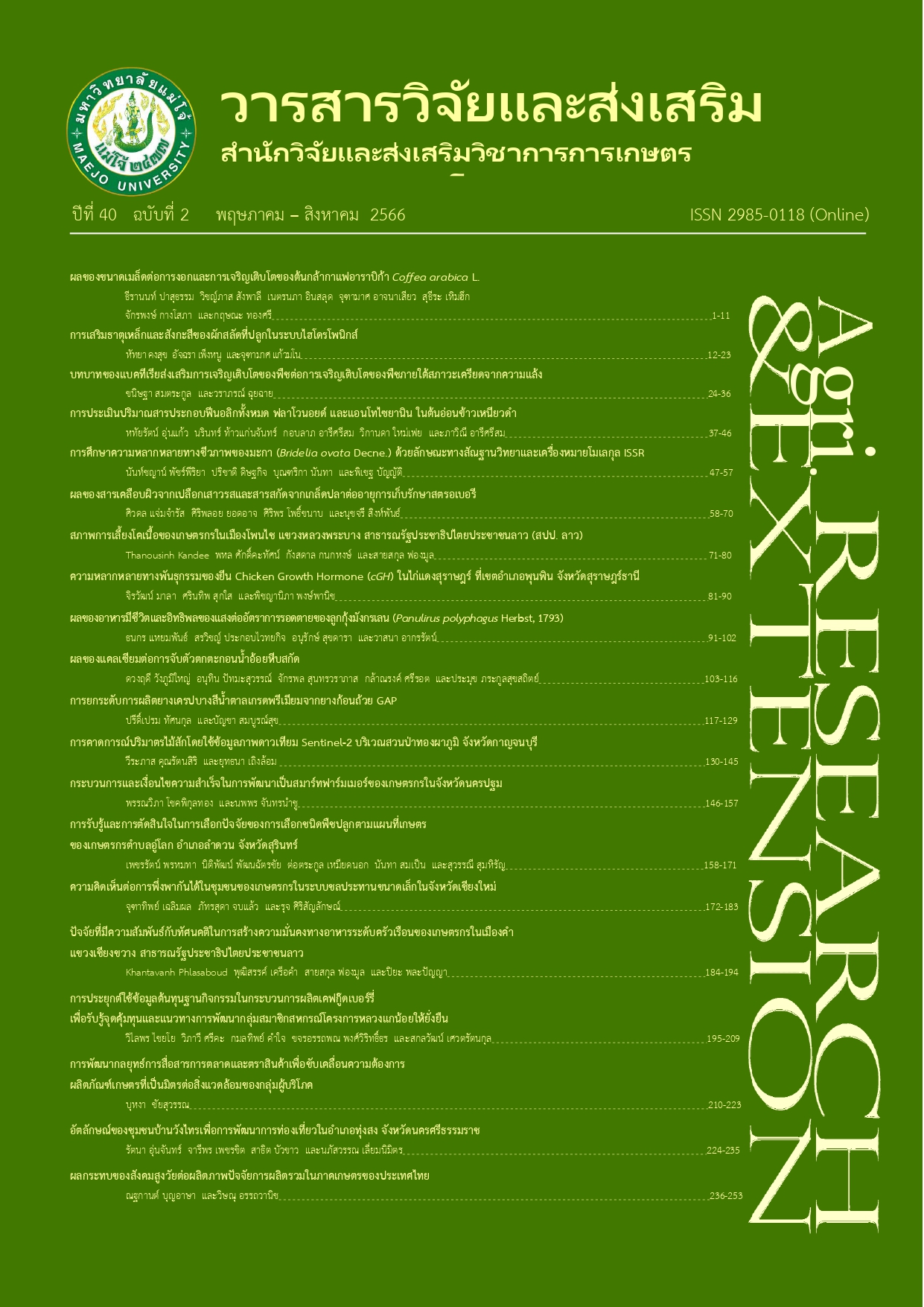การเสริมธาตุเหล็กและสังกะสีของผักสลัดที่ปลูกในระบบไฮโดรโพนิกส์
คำสำคัญ:
เหล็ก, สังกะสี, การเสริมธาตุอาหาร, ผักสลัด , ไฮโดรโพนิกส์บทคัดย่อ
ในปัจจุบันการได้รับธาตุเหล็กและสังกะสีที่ไม่เพียงพอต่อร่างกายในแต่ละวัน กำลังเป็นปัญหาที่พบใน วงกว้าง จึงนำมาสู่การศึกษาผลของการเพิ่มธาตุเหล็กและสังกะสี ต่อการเจริญเติบโตและปริมาณธาตุอาหารในผักสลัดที่ปลูกในระบบไฮโดรโพนิกส์ โดยวางแผนการทดลองแบบ Factorial in Randomized Complete Block Design ประกอบด้วยผักสลัดพันธุ์กรีนคอส ฟิลเลย์ไอซ์เบิร์ก กรีนโอ๊ค เรดโอ๊ค และบัตเตอร์เฮด และสารละลายธาตุอาหารสูตรควบคุม สูตรเพิ่มเหล็กและสูตรเพิ่มสังกะสี ผลการวิจัยพบว่า ผักสลัดเสริมธาตุเหล็กหรือสังกะสี สามารถเจริญเติบโตได้โดยไม่แสดงอาการเป็นพิษ หรือขาดธาตุอาหาร สูตรเพิ่มเหล็กทำให้การเจริญเติบโตของ กรีนคอส ฟิลเลย์ไอซ์เบิร์ก และเรดโอ๊คไม่แตกต่างจาก สูตรควบคุม ผักสลัดมีปริมาณเหล็กเพิ่มขึ้น 1.3-2.3 เท่า โดยฟิลเลย์ไอซ์เบิร์กมีปริมาณเหล็กสูงสุด (471.93 มก./กก.น้ำหนักแห้ง) สำหรับปริมาณฟอสฟอรัส แคลเซียม แมกนีเซียม และแมงกานีสของผักสลัด มีแนวโน้มเพิ่มขึ้น ส่วนสังกะสีและทองแดงมีแนวโน้มลดลง ขณะที่สูตรเพิ่มสังกะสีทำให้เรดโอ๊คมีน้ำหนักสดทั้งต้นเพิ่มขึ้น 58% ปริมาณสังกะสีของผักสลัดเพิ่มขึ้น 4.2-18.9 เท่า โดยบัตเตอร์เฮดและเรดโอ๊คมีปริมาณสังกะสี 376.67 และ 365.80 มก./กก. น้ำหนักแห้ง ตามลำดับ การเพิ่มสังกะสีทำให้ปริมาณแคลเซียมเพิ่มขึ้น ขณะที่ปริมาณฟอสฟอรัส โพแทสเซียม เหล็ก แมงกานีส และทองแดง มีแนวโน้มลดลง ยกเว้นปริมาณเหล็กของเรดโอ๊คที่เพิ่มขึ้น 1.1 เท่า ปริมาณเหล็กและสังกะสีสูงที่สุดในน้ำหนักสดส่วนที่รับประทานได้ของ ฟิลเลย์ไอซ์เบิร์กและบัตเตอร์เฮด เท่ากับ 3.02 และ 2.64 มก./กก. น้ำหนักสด ตามลำดับ ซึ่งไม่เกินค่าปริมาณเหล็กและสังกะสีที่ร่างกายควรได้รับในแต่ละวัน แสดงให้เห็นว่าการเสริมธาตุเหล็กและสังกะสี เป็นแนวทางการพัฒนา ผักสลัดเพื่อสุขภาพได้ในอนาคต
เอกสารอ้างอิง
Balk, J. and T.A. Schaedler. 2014. Iron cofactor assembly in plants. Annual Review of Plant Biology 65: 125-153.
Cakmak, I., M. Kalayci, Y. Kaya, A.A. Torun, N. Aydin, Y. Wang, Z. Arisoy, H. Erdem, A. Yazici, O. Gokmen, L. Ozturk and W.J. Horst. 2010. Biofortification and localization of zinc in wheat grain. Journal of Agricultural and Food Chemistry 58: 9092-9102.
Di Gioia, F., M. Gonnella, V. Buono, O. Ayala and P. Santamaria. 2017. Agronomic, physiological and quality response of romaine and red oak-leaf lettuce to nitrogen input. Italian Journal of Agronomy 12(806): 47-58.
Freitas, M.A., F.H.V. Medeiros, S.P. Carvalho, L.R.G. Guilherme, W.D. Teixeira, H. Zhang and P.W. Paré. 2015. Augmenting iron accumulation in cassava by the beneficial soil bacterium Bacillus subtilis (GBO3). Frontiers in Plant Science 6(596): 1-11.
Giordano, M., C. El-Nakhel, A. Pannico, M.C. Kyriacou, S.R. Stazi, S. De Pascale and Y. Rouphael. 2019. Iron biofortification of red and green pigmented lettuce in closed soilless cultivation impacts crop performance and modulates mineral and bioactive composition. Agronomy 9(290): 1-21.
Gupta, N., H. Ram and B. Kumar. 2016. Mechanism of zinc absorption in plants: uptake, transport, translocation and accumulation. Reviews in Environmental Science and Biotechnology 15: 89-109.
Haleema, B., A. Rab and S.A. Hussain. 2018. Effect of calcium, boron and zinc foliar application on growth and fruit production of tomato. Sarhad Journal of Agriculture 34(1): 19-30.
Iacuzzo, F., S. Gottardi, N. Tomasi, E. Savoia, R. Tommasi, G. Cortella, R. Terzano R. Pinton, L. Dalla Costa and S. Cesco. 2011. Corn salad (Valerianella locusta (L.) Laterr.) growth in a water-saving floating system as affected by iron and sulfate availability: crop growth and food quality as affected by Fe and S availability. Journal of the Science of Food and Agriculture 91: 344-354.
Institute of Medicine (U.S.) Panel on Micronutrients. 2001. DRI: dietary reference intakes for vitamin A, vitamin K, arsenic, boron, chromium, copper, iodine, iron, manganese, molybdenum, nickel, silicon, vanadium, and zinc: a report of the panel on micronutrient. [Online]. Available https://www.ncbi.nlm.nih.gov/books/NBK222310/ (July 8, 2021).
Kalra, Y.P. 1998. Handbook of Reference Methods for Plant Analysis. Boca Raton: CRC Press. 300 p.
Kim, M.J., Y. Moon, J.C. Tou, B. Mou and N.L. Waterland. 2016. Nutritional value, bioactive compounds and health benefits of lettuce (Lactuca sativa L.). Journal of Food Composition and Analysis 49: 19-34.
Majeed, A., W.A. Minhas, N. Mehboob, S. Farooq, M. Hussain, S. Alam and M.S. Rizwan. 2020. Iron application improves yield, economic returns and grain-Fe concentration of mungbean. PloS one 15: e0230720. [Online]. Available https://doi.org/10.1371/journal.pone.0230720 (July 11, 2021).
Montoya, M., A. Vallejo, J. Recio, G. Guardia and J.M. Alvarez. 2020. Zinc–nitrogen interaction effect on wheat biofortification and nutrient use efficiency. Journal of Plant Nutrition and Soil Science 183(2): 169-179.
Pengnoo A., C. Kaewmano, S. Kiatpathomchai and U. Loalae. 2016. Technology of Quality and Safe Hydroponic Vegetable Production by B-Veggie bio-agent: Bacillus subtilis. Bangkok: National Research Council of Thailand. 63 p. [in Thai]
Phulkerd, S., R.S. Gray and A. Chamratrithirong. 2020. The influence of co-residential and non-co-residential living arrangements on sufficient fruit and vegetable consumption in the aging population in Thailand. BMC Geriatrics 20(1): 1-8.
Rout, G.R. and S. Sahoo. 2015. Role of iron in plant growth and metabolism. Reviews in Agricultural Science 3: 1-24.
Samreen, T., H.U. Shah, S. Ullah and M. Javid. 2017. Zinc effect on growth rate, chlorophyll, protein and mineral contents of hydroponically grown mungbeans plant (Vigna radiata). Arabian Journal of Chemistry 10: 1802-1807.
Shi, P., B. Li, H. Chen, C. Song, J. Meng, Z. Xi and Z. Zhang. 2017. Iron supply affects anthocyanin content and related gene expression in berries of Vitis vinifera cv. Cabernet Sauvignon. Molecules 22(283): 1-13.
Tanaka, A. and S.A. Navasero. 1966. Interaction between iron and manganese in the rice plant. Soil Science and Plant Nutrition 12: 29-33.
Tsonev, T. and F.J.C. Lidon. 2012. Zinc in plants - an overview 12. Emirates Journal of Food and Agriculture 24: 322-333.
Yousaf, M., S. Bashir, H. Raza, A.N. Shah, J. Iqbal, M. Arif, M.A. Bukhari, S. Muhammad, S. Hashim, J. Alkahtani, M.S. Alwahibi and C. Hu. 2021. Role of nitrogen and magnesium for growth, yield and nutritional quality of radish. Saudi Journal of Biological Sciences 28: 3021-3030.
ดาวน์โหลด
เผยแพร่แล้ว
รูปแบบการอ้างอิง
ฉบับ
ประเภทบทความ
สัญญาอนุญาต
ลิขสิทธิ์ (c) 2023 วารสารวิจัยและส่งเสริมวิชาการเกษตร

อนุญาตภายใต้เงื่อนไข Creative Commons Attribution-NonCommercial-NoDerivatives 4.0 International License.
บทความนี้ได้รับการเผยแพร่ภายใต้สัญญาอนุญาต Creative Commons Attribution-NonCommercial-NoDerivatives 4.0 International (CC BY-NC-ND 4.0) ซึ่งอนุญาตให้ผู้อื่นสามารถแชร์บทความได้โดยให้เครดิตผู้เขียนและห้ามนำไปใช้เพื่อการค้าหรือดัดแปลง หากต้องการใช้งานซ้ำในลักษณะอื่น ๆ หรือการเผยแพร่ซ้ำ จำเป็นต้องได้รับอนุญาตจากวารสาร





